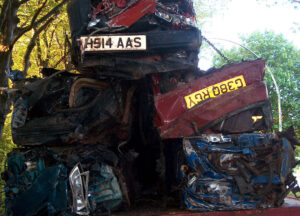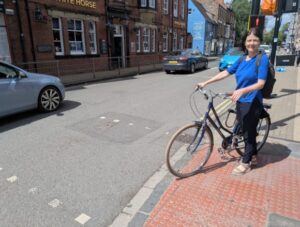Matthew Clark, Programme Manager – Air Quality, Sustainable Growth/Public Health Service at Hertfordshire County Council, explores the air quality issues affecting rural authorities
Across any authority, air quality has many implications including health, sustainability, transport and urban planning. Using the cleaner air agenda to promote these connections is a gift and can help integrate the agenda across council functions.
Pollutant concentrations can be as high in market towns as city centres. Often situated in defendable positions on top of hills, or within river loops, the location met the needs of the time. Fast forward several hundred years, introduce motor vehicles and the very same features contribute to challenges we see today with steep inclines creating additional pollution from the tail pipe and bottlenecks creating congestion.
Adding the built environment to the picture, many historic towns have conservation areas and listed buildings rightly protecting the character of the townscape. This can restrict options for improving air quality and hamper adoption of other sustainable features. With cleaner air and carbon reduction intrinsically linked, future discussion is needed here, but that’s a separate topic for another day.
When travelling, be it for education, work or health care, distances travelled are longer in rural areas. This can shift the purchasing decisions of the local market toward diesel vehicles with historically higher NO2 emissions – the pollutant of concern in most rural Air Quality Management Areas (AQMA). The National Atmospheric Emissions Inventory (NAEI) suggests a 2% increase in diesel in rural areas compared to urban areas outside of London. Distances and a lack of infrastructure can also detract from investing in cleaner fuelled alternatives, such as electric vehicles.
Distance to travel combined with lower population concentrations create a challenge for mass transit options. Rural authorities are acutely aware of the need to connect people and place. Many public transport routes are subsidised, but this can come with a large price tag and may not be sustainable. On-demand dial-a-ride public transport options such as the HertsLynx service in Hertfordshire are just one-way authorities may evolve.
The distance aspect can also undermine active travel promotion. Sparsely used and isolated routes can be perceived as a personal safety risk. It is one thing to promote active travel within an urban setting where most journeys may be short and wellpopulated, and an entirely different thing in a rural setting where journeys tend to be longer and on outlying routes. This can again promote the private motor vehicle as the first option for a journey.
An aspect of working in a rural authority environmental protection team is the spread of regulatory duties covering typically urban activity as well as more rural flavoured activity such as private water sampling. There are no additional resources provided to reflect the breadth of duties required, yet additional expertise may be necessary. Resource pressure yet again rears its head.
Rural authorities are often attractive to people as retirement options and aspirational for those looking to move away from urban settings later in life. This top-heavy demographic pyramid can create resource pressures for local authorities. In contrast rural authorities often receive less funding per capita through, for example, central public health grants. Finding resource for local air quality action can therefore be a challenge. The need for a fairer way of providing funding to rural authorities is something most officers will have reflected upon at one time or another.
Some of the most effective yet divisive tools to improve air quality have been Clean Air Zones (CAZ). Significant resource from central government to promote cleaner air through mandated action ‘Local NO2’ plans has been provided. The list mandated for action was increased through the work of Client Earth who successfully challenged the government’s stance on the number of sites required to make changes and the fruits of these labours are now being seen with Sheffield introducing their CAZ last month. Even before CAZ come into force, improvements are often felt in the run up as the fleet moves to avoid the charges – this is highlighted by the Bradford Council case study previously brought to the Air Quality News conference.
So, how feasible is it for more rural locations to consider CAZ? Without a dedicated funding source from government the costs alone may be considered prohibitive. The practicalities can also be a challenge. A large urban centre may have economies of scale in terms of placement of infrastructure to facilitate the CAZ. A rural location may need to consider several separate areas of concern which are widely dispersed across the county. On an area basis, the finance and practical challenges may not stack up.
An aspect for rural authorities to consider is the impact of neighbouring city/conurbation CAZ’s on their patch. Some cleaner air improvements may trickle out to the rural surrounding and are always welcomed. However, there are other impacts, such as community severance for those living adjacent to CAZ boundaries, which may have a disproportionate impact on people with low incomes. Given these types of impacts, full support for such schemes can be difficult to achieve particularly if funding to facilitate behavioural change, such as scrappage schemes, stops at the CAZ boundary.
Moving away from the transport angle we may see further nuance in a rural setting in relation to the rising PM2.5 source in domestic solid fuel-burning. Tools such as smoke control areas may be straightforward (in principle rather than practice) in a city scenario where everyone has an alternative heating source. Rural areas, where there may be dwellings off grid, may require much more careful consideration of the message. It is not a one size fits all agenda although there is certainly a need for a clear information campaign to provide information on the health impacts of domestic solid fuel burning, the largest source of PM2.5 in the UK, to the whole population.
One final aspect of the rural setting is the agricultural contribution to ammonia pollution. Secondary pollutants such as PM2.5’s can form, impacting on human health while the impact on sensitive ecological systems can also be significant. Technical solutions exist: scrubbing exhaust air from intensive poultry units; injecting slurry into the soil and covering slurry stores. There is currently a renewed focus on this agenda setting good practice for some of these activities. But is guidance alone enough?
So, to sum up there are challenges to creating cleaner air in rural authorities with distance of journeys, a dispersed population, lack of resource and additional pollution sources. A fairer deal for rural authorities would be welcomed to reflect these points. Despite additional resources always being welcome, the promotion of bidding processes for levelling up, to compensate for an inequity in the primary funding routes, is not an adequate solution.
A nuanced approach to information provision is needed to land cleaner air messages across all parts of rural authorities from the town centres to the hamlets. Information, when it lands, is the first step to stimulate a behavioural change and a call to action to enable a move to a future providing cleaner air for all.
An advantage rural authorities may have in the agenda is the ability to promote low exposure routes. There may be more ‘less trafficked’ routes in rural authorities outside of hotspots compared to a city environment. Hertfordshire County Council are currently producing information to promote the use of less trafficked routes and are considering how countryside rights of way can promote movement with low pollution exposure and thanks DEFRA for contributing to this project with grant funding.
This article first appeared in the March issue of Air Quality News Magazine.

















Thank you, Matthew. I couldn’t agree more where you say, “need for a clear information campaign to provide information on the health impacts of domestic solid fuel burning, the largest source of PM2.5 in the UK, to the whole population”. Yes, smoke from domestic chimneys is certainly a problem in our cities and towns but it can also be a nightmare in village streets. Just one really bad burner can pollute a whole neighbourhood. And there is the mistaken belief, by quite a few, that wood burning, inlcuding bonfires, is fine in rural areas because the air there is almost “empty” so it doesn’t matter. Not so. As you rightly say, “Information is the first step to stimulate a behavioural change”. The next step is helping families pay for cleaner, cheaper ways to heat their homes and get back and forth to work. Finding the money for improvements may still be a bottleneck, even with local authority grants.